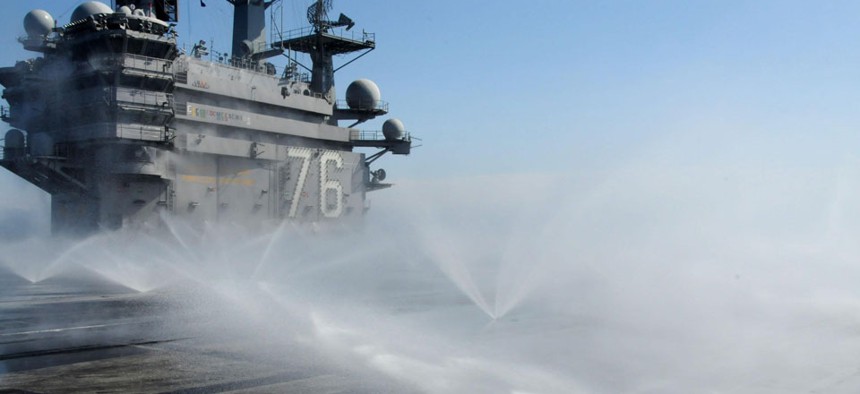Radiation Levels Spiked for Navy Responders to Japan Nuke Disaster, Report Says

The aircraft carrier USS Ronald Reagan conducts a countermeasure wash down to decontaminate the flight deck while the ship is operating off the coast of Japan in 2011. Defense Department
Officials maintain the worst-case exposure for crew members was less than 25 percent of the annual radiation exposure from natural sources.
The USS Ronald Reagan aircraft carrier experienced radiation levels 30 times above normal while its crew conducted disaster relief operations off the coast of Japan in March 2011 after a tsunami damaged reactors at the Fukushima Daiichi Nuclear Power Plant, according to a new analysis published on Monday.
That analysis came just days after 79 Reagan crewmen filed an amended lawsuit in federal court in San Diego against the plant’s operator, Tokyo Electric Power Co. The plaintiffs seek $1 billion in damages, claiming the company was negligent in construction and operation of the plant and during the subsequent meltdown of its reactors following the tsunami March 11, 2011.
Kyle Cleveland, a sociology professor at Temple University Japan, cited transcripts of a conference call between high level Navy and Energy Department officials in an article in the Asia-Pacific Journal, “Mobilizing Nuclear Bias: The Fukushima Nuclear Crisis and the Politics of Uncertainty.” The transcripts, which Cleveland obtained through the Freedom of Information Act, show concern among U.S. officials discussing the level of radioactivity on the Reagan on March 13.
In that transcript, Adm. Kirkland H. Donald, at the time director of naval nuclear propulsion, said the level of radioactivity in the plume emitted from the plant “was probably more significant than what we had originally thought.”
Troy Mueller, deputy administrator for naval reactors at Energy, said the radiation is “about 30 times what you would detect just on a normal air sample out at sea . . . So it's much greater than what we had thought. We didn't think we would detect anything at 100 miles.”
On the call, Deputy Secretary of Energy Daniel Poneman asked Mueller if the radiation detected on the Reagan “is significantly higher than anything you would have expected?” Mueller answered, “Yes sir.”
Mueller also said that after 10 hours, the amount of radiation experienced on the ship could become a “thyroid dose issue.” Overdoses of radiation can destroy the thyroid gland.
Navy spokeswoman Lt. Cmdr. Sarah Flaherty said in an email that a tri-service dose assessment and registry working group determined that the highest whole body dose to any Reagan crewmember is much lower than levels of radiation exposure associated with the occurrence of long-term health effects.
She said the worst-case radiation exposure for a crewmember on USS Ronald Reagan was less than 25 percent of the annual radiation exposure to a member of the U.S. public from natural sources of background radiation, such as the sun, rocks and soil.
During the disaster relief operation, Flaherty said, the Navy took proactive measures to control, reduce, and mitigate the levels of Fukushima-related contamination on U.S. Navy ships and aircraft. “Ship's company used sensitive instruments to identify areas containing radioactivity, took action to control the spread of the radioactivity, and washed and cleaned areas of the ship that contained radioactivity,” Flaherty said.
“Potentially contaminated personnel were surveyed with sensitive instruments and, if necessary, decontaminated. The low levels of radioactivity from the Fukushima nuclear power plant identified on U.S. Navy ships, their aircraft, and their personnel were easily within the capability of ship's force to remedy,” Flaherty said
The law firm Bonner & Bonner, based in Sausalito, Calif., charged in its lawsuit against Tokyo Electric Power that crewmen on the Reagan exposed to radiation from the Fukushima plant “now endure a lifetime of radiation poisoning and suffering which could have and should have been avoided,” if the company had not been negligent in construction and operation of the facility.
The suit also charged that sailors aboard the Reagan “have been and will be required to undergo further medical testing, evaluation and medical procedures, including but not limited to chelation therapy, bone marrow transplants and/or genetic reprogramming.”
Sailors on the Reagan were exposed to both airborne radiation and radiation from contaminated seawater, the suit said. One plaintiff said the ship was taking in sea water, “but obviously the ship can't filter out the radiation. Water we all showered with, drank, brushed our teeth, and had our food cooked with.”
Tokyo Electric Power registered as a California foreign corporation in 2003. As a result, TEPCO is subject to the jurisdiction of the United States Federal District Court, the suit said.






